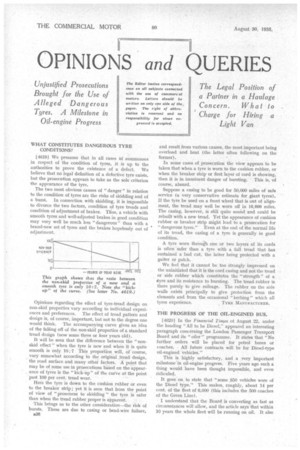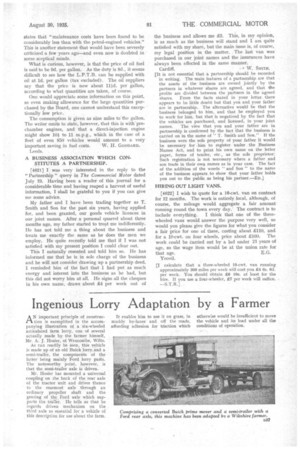OPINIONS and QUERIES
Page 42

Page 43

If you've noticed an error in this article please click here to report it so we can fix it.
• WHAT CONSTITUTES DANGEROUS TYRE CONDITIONS?
146191 We presume that in all cases of summonses in respect of the condition of tyres, it is up to the authorities to prove the existence of a defect. We believe that no legal definition of a defective tyre exists. but the prosecution appears to take as the sole criterion the appearance of the tyre.
The two most obvious causes of " danger " in relation to the condition of tyres are the risks of skidding and of a burst. In connection with skidding, it is impossible . to divorce the two factors, condition of tyre treads and condition of adjustment of brakes. Thus, a vehicle with smooth tyres and well-adjusted brakes in good condition may very well be much less "dangerous" than with a brand-new set of tyres and the brakes hopelessly out of adjustment.
Opinions regarding the effect of tyre-tread design on non-skid properties vary according to individual experiences and preferences. The effect of tread pattern and design is, of course, important, but not to the degree one would think. The accompanying curve gives an idea of the falling off of the non-skid properties of a standard tread design (now some three or four years old).
It will be seen that the difference between the "nonskid effect" when the tyre is new and when it is quite smooth is only 10: 7 This proportion will, of course, vary somewhat according to the original tread design, the road surface and many othei factors. A point that may be of sonic use in prosecutions based on the appear
ance of tyres is the "kick-up" of the curve at the point past 100 per cent, tread wear.
Here the tyre is down to the cushion rubber or even to the breaker strip; yet it is seen that from the point of view of "proneness to skidding " the tyre is safer than when the tread rubber proper is apparent. • This brings us to the other consideration—the risk of bursts. These are due to casing or bead-wire failure, B36 and result from various causes, the most important being overload and heat (the latter often following on the former).
In some cases of prosecution the view appears to be taken that when a tyre is worn to the cushion rubber, or when the breaker strip or first layer of cord is showing, then it is in imminent danger of bursting. This is, of course, absurd.
Suppose a casing to be good for 50,000 miles of safe service (a very conservative estimate for giant tyres). If the tyre be used on a front wheel that is out of alignment, the tread may well be worn off in 10,000 miles. The casing, however, is still quite sound and could be rebuilt with a new tread. Yet the appearance of cushion rubber or breaker strip might lead to a prosecution for • 'dangerous tyres." Even at the end of the normal life of its tread, the casing of a tyre is generally in good condition.
A tyre worn through one or two layers of its cords is often safer than a tyre with a full tread that has sustained a bad cut, the latter being protected with a gaiter or patch.
We feel that it cannot be too strongly impressed on the uninitiated that it is the cord casing and not the tread or side rubber which constitutes the " strength " of a 'tyre and its resistance to bursting. The tread rubber is there purely to give mileage. The rubber on the side walls exists principally to give protection from the elements and from the occasional " kerbing " which all tyres experience. TYRE MANUFACTURER.
THE PROGRESS OF THE OIL.ENGINED BUS.
[4620] In the Financial Times of August 22, under the heading "All to be Diesel," appeared an interesting paragraph concerning the London Passenger Transport Board and its " oiler " programme. It states that "No further orders will be placed for petrol buses or
coaches. All future contracts will be for Diesel-type oil-engined vehicles."
This is highly satisfactory, and a very important milestone in oil-engine progress. Five years ago such a thing would have been thought impossible, and even ridiculed.
It goes on to state that "some $50 vehicles were of the Diesel type." This makes, roughly, about 14 per cent, of the fleet of 6,000 (this includes the 500 coaches of the Green Line).
• I understand that the Board is converting as fast as circumstances will allow, and the article says that within 10 years the whole fleet will be running on oil. It also states that "maintenance costs have been found to be considerably less than with the petrol-engined vehicles," This is another statement that would have been severely criticized a few years ago—and even now is doubted in some sceptical minds.
What is curious, however, is that the price of oil fuel is said to be Dd. per gallon. As the duty is 8d., it seems difficult to see how the L.P.T.B. can be supplied with oil at id. per gallon (tax excluded). The oil suppliers say that the price is now about 111d. per gallon, according to what quantities are taken, of course.
One would appreciate some information on this point, as even making allowance for the large quantities purchased by the Board, one cannot understand this exceptionally low price.
The consumption is given as nine miles to`the gallon. The writer omits to state, however, that this is with-prechamber engines, and that a direct-injection engine might show 101 to 11 m.p.g., which in the case of a fleet of even 850 vehicles would amount to a very
important saving in fuel costs. W. H. GODDARD. Leeds.
A BUSINESS ASSOCIATION WHICH CONSTITUTES A PARTNERSHIP.
[4621] I was very interested in the reply to the " Partnership " query in The Commercial Motor dated July 19. Having been a reader of this journal for a considerable time and having reaped a harvest of useful information, I shall be grateful to you if you can give me some advice.
My father and I have been trading together as T. Smith and Son for the past six years, having applied for, and been granted, our goods vehicle licences in our joint names. After a personal quarrel about three months ago, my father started to treat me indifferently. He has not told me a thing about the business and treats me exactly the same as he does the men we employ. He quite recently told me that if I was not satisfied with my present position I could clear out.
This I naturally resented and told him so. He has informed me that he is in sole charge of the business and he will not consider drawing up a partnership deed.
reminded him of the fact that I had put as much energy and interest into the business as he had, but this did not worry him at all. He signs all the cheques in his own name, draws about £.4 per week out of the business and allows me £3. This, in my opinion, is as much as the business will stand and L am quite satisfied with my share, but the main issue is, of course, my legal position in the matter. The last van was purchased in our joint names and the insurances have always been effected in the same manner.
Cardiff. W. SMITH.
[It is not essential that a partnership should be recorded in writing. The main features of a partnership are that the assets of the business are owned jointly by the partners in whatever shares are agreed, and that the profits are divided between the partners in the agreed shares. From the facts stated in your letter_ there appears to be little doubt but that you and your father are in partnership. The alternative would be that the business belonged to him, and that he employed you to work for him, but that is negatived by the fact that the vehicles are purchased, and licensed, in your joint names. The view that you and your father are in partnership is confirmed by the fact that the business is carried on in the name of "T. Smith and Son." If the business were the sole property of your father it would be necessary for him to register under the Business Names Act, and to print his own name on the letter paper, forms of tender, etc., as the sole proprietor: Such registration is not necessary where a father and son trade in their own names as in your case. The fact of the addition of the words " and Son " to the name of the business appears. to show that your father holds you out to the public as being his partner.—ED.]
HIRING OUT LIGHT VANS.
[4622] I wish to quote for a 10-cwt. van on contract for 12 months. The work is entirely local, although, of course, the mileage would aggregate a fair amount running round the town every day: The contract is to include everything. I think that one of the threewheeled vans would answer the purpose very well, so would you please give the figures for what you consider a fair price for one of these, costing about £110, and for a 10-cwt. on four wheels, price about £160. The work could be carried out by a lad under 21 years of age, so the wage item would be at the union rate for
that age. • E.G. Yeovil.
[I calculate that a three-wheeled 10-cwt. van running approximately 300 miles per week will cost you £4 6s. 6d. per week. You should obtain 26 10s. at least for the hire. If you use a four-wheeler, 27 per week will suffice. . —S.T.R.]












































































